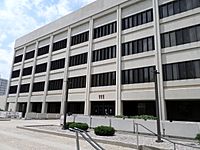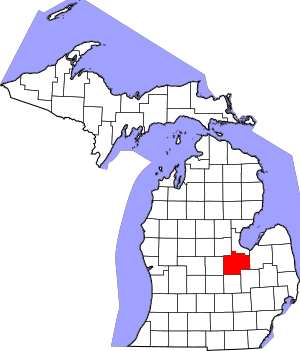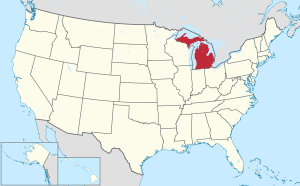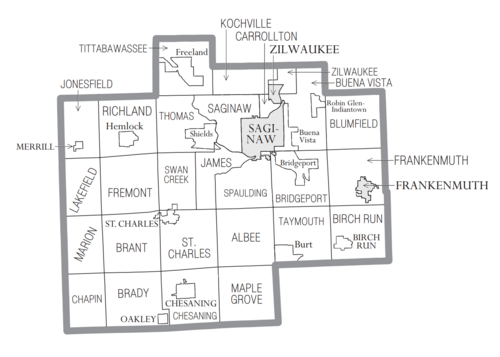Saginaw County, Michigan facts for kids
Quick facts for kids
Saginaw County
|
|||
|---|---|---|---|
| County of Saginaw | |||

Saginaw County Governmental Center in Saginaw
|
|||
|
|||

Location within the U.S. state of Michigan
|
|||
 Michigan's location within the U.S. |
|||
| Country | |||
| State | |||
| Founded | February 9, 1835 | ||
| Seat | Saginaw | ||
| Largest city | Saginaw | ||
| Area | |||
| • Total | 816 sq mi (2,110 km2) | ||
| • Land | 800 sq mi (2,000 km2) | ||
| • Water | 16 sq mi (40 km2) 1.9%% | ||
| Population
(2020)
|
|||
| • Total | 190,124 | ||
| • Density | 250/sq mi (100/km2) | ||
| Time zone | UTC−5 (Eastern) | ||
| • Summer (DST) | UTC−4 (EDT) | ||
| Congressional district | 8th | ||
Saginaw County (sag-UH-naw) is a county located in the U.S. state of Michigan. As of the 2020 Census, the population was 190,124. The county seat is Saginaw. The county was created by September 10, 1822, and was fully organized on February 9, 1835. The etymology of the county's name is uncertain. It may be derived from Sace-nong or Sak-e-nong (English: Sauk land), as the Sauk (French: Sac) tribe is believed by some to have once lived there. A more likely possibility is that it comes from Ojibwe words meaning "place of the outlet" –sag (English: an opening) and ong (English: place of). See List of Michigan county name etymologies.
Saginaw County comprises the Saginaw, MI Metropolitan Statistical Area and is included in the Saginaw-Midland-Bay City Combined Statistical Area, the 5th largest metropolitan area in Michigan.
Contents
Etymology
The name Saginaw is widely believed to mean "where the Sauk were" in Ojibwe, from Sace-nong or Sak-e-nong (Sauk Town), due to the belief that the Sauk once lived there. But it is more likely that the name means "place of the outlet", from the Ojibwe sag (opening) and ong (place of).
When Natives told Samuel de Champlain that the Sauk nation was on the western shore of Lake Michigan, Champlain mistakenly placed them on the western shore of Lake Huron. This mistake was copied on subsequent maps, and future references identified this as the place of the Sauks. Champlain himself never visited what is now Michigan.
History
The area was inhabited from about 1000 B.C. to 1000 A.D. by the Native American Hopewell culture, followed by the Anishnabeg. Some historians believe that the Sauk at one time lived in the area and were driven out by Ojibwe (Chippewa), before the area was first visited by Europeans.
The Saginaw region includes an extensive network of many rivers and streams which converge into the Saginaw River and provided a means for easy travel for the Native American population among numerous settlements and hunting areas, as well as access to Lake Huron. Saginaw was also a frequent meeting location for councils of the Ojibwe, Pottawatomi, and Ottawa—the Three Fires of the Anishnabeg.
What is today Saginaw County was inhabited by the Ojibwe at the time of the arrival of Euro-Americans. The Ojibwe were still the dominant force in the area in the 1820s, and in 1827 they were attacked by a two groups of Winnebago people coming from Wisconsin. The Ojibwe prevailed in this fight with the aid of local Euro-American settlers.
In 1853 the Ojibwe and Ottawa both established large hunting camps along the Saginaw River, although Euro-American settlers were beginning to establish saw mills and farms in the area by that point.
Geography
According to the U.S. Census Bureau, the county has a total area of 816 square miles (2,110 km2), of which 800 square miles (2,100 km2) is land and 16 square miles (41 km2) (1.9%) is water. It is part of the Flint/Tri-Cities region of Mid-Michigan. The median elevation in Saginaw County, Michigan is 620 feet (190 m) above sea level.
Primary rivers
Wildlife refuge
Adjacent counties
- Bay County (northeast)
- Midland County (northwest)
- Tuscola County (east)
- Gratiot County (west)
- Genesee County (southeast)
- Shiawassee County (south)
- Clinton County (southwest)
Demographics
| Historical population | |||
|---|---|---|---|
| Census | Pop. | %± | |
| 1840 | 892 | — | |
| 1850 | 2,609 | 192.5% | |
| 1860 | 12,693 | 386.5% | |
| 1870 | 39,097 | 208.0% | |
| 1880 | 59,095 | 51.1% | |
| 1890 | 82,273 | 39.2% | |
| 1900 | 81,222 | −1.3% | |
| 1910 | 89,290 | 9.9% | |
| 1920 | 100,286 | 12.3% | |
| 1930 | 120,717 | 20.4% | |
| 1940 | 130,468 | 8.1% | |
| 1950 | 153,515 | 17.7% | |
| 1960 | 190,752 | 24.3% | |
| 1970 | 219,743 | 15.2% | |
| 1980 | 228,059 | 3.8% | |
| 1990 | 211,946 | −7.1% | |
| 2000 | 210,039 | −0.9% | |
| 2010 | 200,169 | −4.7% | |
| 2020 | 190,124 | −5.0% | |
| 2023 (est.) | 187,782 | −6.2% | |
| U.S. Decennial Census 1790–1960 1900–1990 1990–2000 2010–2019 |
|||
The 2010 United States Census indicates Saginaw County had a 2010 population of 200,169. This is a decrease of -9,870 people from the 2000 United States Census. Overall, the county had a -4.7% growth rate during this ten-year period. In 2010 there were 79,011 households and 52,287 families in the county. The population density was 250.2 per square mile (96.6 per square kilometer). There were 86,844 housing units at an average density of 108.5 per square mile (41.9 per square kilometer). The racial and ethnic makeup of the county was 70.5% White, 18.6% Black or African American, 0.3% Native American, 1.0% Asian, 7.8% Hispanic or Latino, 0.1% from other races, and 1.6% from two or more races.
There were 79,011 households, out of which 30.5% had children under the age of 18 living with them, 45.4% were husband and wife families, 16.0% had a female householder with no husband present, 33.8% were non-families, and 28.2% were made up of individuals. The average household size was 2.44 and the average family size was 2.99.
In the county, 23.4% of the population was under the age of 18, 10.6% from 18 to 24, 22.9% from 25 to 44, 27.8% from 45 to 64, and 15.3% was 65 years of age or older. The median age was 40 years. For every 100 females there were 93.6 males. For every 100 females age 18 and over, there were 90.4 males.
The 2010 American Community Survey 1-year estimate indicates the median income for a household in the county was $41,938 and the median income for a family was $52,243. Males had a median income of $27,691 versus $16,488 for females. The per capita income for the county was $21,025. About 12.4% of families and 16.9% of the population were below the poverty line, including 24.1% of those under the age 18 and 10.1% of those age 65 or over.
Religion
The Roman Catholic Diocese of Saginaw is the controlling regional body for the Catholic Church.
Economy
The largest employers in Saginaw County are:
| # | Employer | # of employees |
|---|---|---|
| 1 | Nexteer Automotive | 5200 |
| 2 | Covenant HealthCare | 4512 |
| 3 | St. Mary's of Michigan | 1800 |
| 4 | Morley Companies | 1750 |
| 5 | Meijer | 1425 |
| 6 | Saginaw Valley State University | 1071 |
| 7 | Hemlock Semiconductor Corporation | 1000 |
| 8 | Frankenmuth Bavarian Inn | 940 |
| 9 | Aleda E. Lutz Veteran Affairs Medical Center | 904 |
| 10 | County of Saginaw | 676 |
| 11 | Saginaw Public Schools | 657 |
| 12 | Fashion Square Mall | 650 |
| 13 | Saginaw Township Community Schools | 621 |
| 14 | Saginaw Intermediate School District | 613 |
| 15 | Frankenmuth Insurance | 694 |
Transportation
Saginaw County was the destination of a Sauk footpath that became one of the first roads in what is now Michigan, the Saginaw Trail. The trail, first authorized in 1819, was completed to Saginaw in 1841. Since then, Saginaw's access to the outside world has expanded with the development of maritime, rail, air, and freeway links to the major cities of Michigan and neighboring states and nations.
Airports
Scheduled airline service is available from MBS International Airport near Freeland, Michigan and Bishop International Airport in Flint, Michigan. Harry Browne Airport in Buena Vista Charter Township also serves the region.
Highways
 I-75, a major north–south freeway running from Sault Ste. Marie, Michigan to Miami-Dade County, Florida
I-75, a major north–south freeway running from Sault Ste. Marie, Michigan to Miami-Dade County, Florida I-675, a business route freeway from Interstate 75 passing through downtown Saginaw
I-675, a business route freeway from Interstate 75 passing through downtown Saginaw US 23
US 23 M-13 runs from I-69 through downtown Saginaw and north to Standish.
M-13 runs from I-69 through downtown Saginaw and north to Standish. M-15
M-15 M-30
M-30 M-46 is a cross peninsular road, running across the mitten and the thumb—from Port Sanilac on the Lake Huron shore; through Saginaw near Saginaw Bay; and then on to Muskegon on the Lake Michigan shore. This east-west surface route nearly bisects the Lower Peninsula of Michigan latitudinally.
M-46 is a cross peninsular road, running across the mitten and the thumb—from Port Sanilac on the Lake Huron shore; through Saginaw near Saginaw Bay; and then on to Muskegon on the Lake Michigan shore. This east-west surface route nearly bisects the Lower Peninsula of Michigan latitudinally. M-47 passes through the western suburbs and provides a direct connection to MBS International Airport in Freeland before ending at US 10 in nearby Bay County.
M-47 passes through the western suburbs and provides a direct connection to MBS International Airport in Freeland before ending at US 10 in nearby Bay County. M-52 runs from the Ohio border through Adrian and Owosso before ending at M-46, in the western suburbs of Saginaw. M-52 also provides an alternate connection to Lansing, Michigan's state capitol.
M-52 runs from the Ohio border through Adrian and Owosso before ending at M-46, in the western suburbs of Saginaw. M-52 also provides an alternate connection to Lansing, Michigan's state capitol. M-54
M-54 M-57
M-57 M-58 runs from M-47 to I-675.
M-58 runs from M-47 to I-675. M-81 runs east from M-13 to Caro and Cass City and ends at M-53 in Sanilac County.
M-81 runs east from M-13 to Caro and Cass City and ends at M-53 in Sanilac County. M-83
M-83 M-84 runs from M-25 in downtown Bay City to M-58 in Saginaw.
M-84 runs from M-25 in downtown Bay City to M-58 in Saginaw.
Maritime
The Saginaw River is maintained by the Corps of Engineers, and from time to time, dredged to maintain a shipping channel down the river to Bay City, and from there, to the Great Lakes.
Education
Primary and secondary education
Public schools
Most of Saginaw County is served by the Saginaw Intermediate School District (SISD), which coordinates the efforts of local boards of education, but has no operating authority over schools. Local school boards in Michigan retain great autonomy over day-to-day operations. A number of charter schools also operate in the county.
School districts in the county (including any with any territory, no matter how slight, even if the schools and/or administration are in other counties) include:
- Ashley Community Schools
- Bay City School District
- Birch Run Area School District
- Breckenridge Community Schools
- Bridgeport-Spaulding Community School District
- Carrollton School District
- Chesaning Union Schools
- Clio Area School District
- Frankenmuth School District
- Freeland Community School District
- Hemlock Public School District
- Merrill Community Schools
- Montrose Community Schools
- New Lothrop Area Public School
- Ovid-Elsie Area Schools
- Reese Public Schools
- Saginaw City School District
- Saginaw Township Community Schools
- St. Charles Community Schools
- Swan Valley School District
Former school districts include:
- Buena Vista School District
Higher education
- Saginaw Valley State University (SVSU) is a four-year state university located in eastern Kochville Township.
- Delta College is a two-year community college that serves Saginaw County, but is located in neighboring Bay County, a few miles to the north of the SVSU campus.
Notable natives
- George C. Hinkley (1892-1936), Wisconsin State Assemblyman and businessman, was born in Saginaw County.
- Theodore Roethke (1908–1963) Pulitzer prize and National Book Award-winning poet was born and buried here.
Historical markers
There are twenty eight recognized historical markers in the county: They are:
- Bliss Park
- Burt Opera House / Wellington R. Burt
- Coal Mine No. 8
- The Cushway House / Benjamin Cushway and Adelaide Cushway
- First Congregational Church [Saginaw]
- Fowler Schoolhouse (Fremont Township)
- Frankenmuth / Saint Lorenz Evangelical Lutheran Church
- Frankenmuth Bavarian Inn
- Freeland United Methodist Church
- George Nason House
- Hess School
- Hoyt Library
- Leamington Stewart House
- Michigan's German Settlers
- Morseville Bridge
- Presbyterian Church of South Saginaw
- Saginaw Club
- Saginaw Oil Industry
- Saginaw Post Office
- Saginaw Valley Coal
- Saginaw Valley Lumbering Era
- St. Mary's Hospital
- Saint Michael Catholic Parish
- St. Paul's Episcopal Mission
- Shroeder House
- Theodore Roethke / Childhood Home
Communities

Cities
- Frankenmuth
- Saginaw (county seat)
- Zilwaukee
Villages
Charter townships
- Bridgeport Charter Township
- Buena Vista Charter Township
- Saginaw Charter Township
Civil townships
- Albee Township
- Birch Run Township
- Blumfield Township
- Brady Township
- Brant Township
- Carrollton Township
- Chapin Township
- Chesaning Township
- Frankenmuth Township
- Fremont Township
- James Township
- Jonesfield Township
- Kochville Township
- Lakefield Township
- Maple Grove Township
- Marion Township
- Richland Township
- Spaulding Township
- St. Charles Township
- Swan Creek Township
- Taymouth Township
- Thomas Township
- Tittabawassee Township
- Zilwaukee Township
Census-designated places
Other unincorporated communities
- Alicia
- Blumfield Corners
- Brady Center
- Brant
- Chapin
- Clausedale
- Crow Island
- Dice
- Fenmore
- Fergus
- Fordney
- Fosters
- Frankentrost
- Frost
- Galloway
- Garfield
- Gera
- Groveton
- Indiantown
- Iva
- Kochville
- Lakefield
- Lawndale
- Layton Corners
- Luce
- Marion Springs
- Morseville
- Nelson
- Orr
- Racy
- Paines
- Parshallburg
- Roosevelt
- Shattuckville
- Swan Creek
- Taymouth
See also
 In Spanish: Condado de Saginaw para niños
In Spanish: Condado de Saginaw para niños




